Portal:Argentina/Selected article
Selected article 1
Portal:Argentina/Selected article/1

Selected article 2
Portal:Argentina/Selected article/2
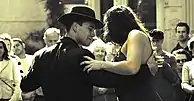
Selected article 3
Portal:Argentina/Selected article/3
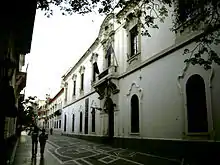
Selected article 4
Portal:Argentina/Selected article/4
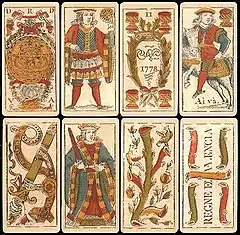
Selected article 5
Portal:Argentina/Selected article/5 Sos Mi Vida (Lit: You're My Life / English: You Are the One) is a 2006 Argentine romantic comedy television series, directed by Rodolfo Antúnez and Jorge Bechara and broadcast by El Trece between January 16, 2006 and January 9, 2007. It is the second telenovela starring Facundo Arana and Natalia Oreiro as lead actors. The production included many location shootings, even during the 2006 FIFA World Cup in Germany, and many guest stars. During its broadcast its overall rating averaged 26.9 points. It was critically acclaimed, and won four Martín Fierro Awards and three Clarín Awards. It was sold to more than 40 countries and had remakes in Mexico, Poland and Portugal. (Full article...)
Selected article 6
Portal:Argentina/Selected article/6

Selected article 7
Portal:Argentina/Selected article/7
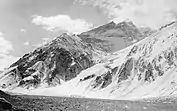
Selected article 8
Portal:Argentina/Selected article/8
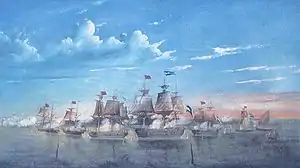
Selected article 9
Portal:Argentina/Selected article/9

Selected article 10
Portal:Argentina/Selected article/10
.JPG.webp)
The condor is primarily a scavenger, feeding on carrion. It prefers large carcasses, such as those of deer or cattle. It reaches sexual maturity at five or six years of age and nests at elevations of up to 5,000 m (16,000 ft), generally on inaccessible rock ledges. One or two eggs are usually laid. It is one of the world's longest-living birds, with a lifespan of up to 100 years old in captivity. (Full article...)
Selected article 11
Portal:Argentina/Selected article/11

The disease may also be spread through blood transfusion and organ transplantation, ingestion of food contaminated with parasites, and from a mother to her fetus. The symptoms of Chagas disease vary over the course of an infection. In the early, acute stage, symptoms are mild and usually produce no more than local swelling at the site of infection. After 4–8 weeks, individuals with active infections enter the chronic phase of Chagas disease that is asymptomatic for 60–80% of chronically infected individuals through their lifetime. (Full article...)
Selected article 12
Portal:Argentina/Selected article/12
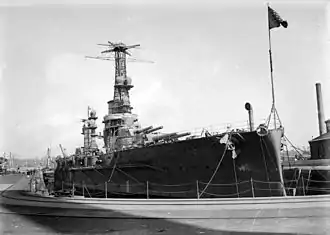
Argentina placed orders for Moreno and her only sister ship, Rivadavia, in reply to a Brazilian naval building program. After Moreno was completed in March 1915, a series of engine problems occurred during her sea trials which delayed her delivery to Argentina to May 1915. During the 1930s the ship was occupied with diplomatic cruises to Brazil, Uruguay, and Europe until the Second World War broke out. During this time, Moreno was employed little as Argentina was neutral. Decommissioned in 1949, Moreno was scrapped in Japan beginning in 1957. (Full article...)
Selected article 13
Portal:Argentina/Selected article/13

In 1907, Brazil placed an order for two of the powerful new "dreadnought" warships as part of a larger naval building program. Argentina quickly responded, as Brazil's ships outclassed anything in the Argentine fleet. After an extended bidding process, contracts to design and build Rivadavia and Moreno were given to the American Fore River Shipbuilding Company. Rivadavia was commissioned on 27 August 1914 but saw no combat in the war, as Argentina remained neutral. Argentina remained neutral until March 1945 when the country declared war on the Axis powers, and Rivadavia did not become involved in the soon-to-end conflict. Stricken from the naval register in 1957, Rivadavia was sold later that year and was broken up for scrap in 1959. (Full article...)
Selected article 14
Portal:Argentina/Selected article/14

During their construction, the Argentine battleships were frequently subject of rumors involving their sale to a foreign country, especially after the beginning of the First World War. Under diplomatic pressure not to sell, Argentina kept the two ships. Throughout their careers, Rivadavia and Moreno were based in Puerto Belgrano and served principally as training ships and diplomatic envoys. They were modernized in the United States in 1924 and 1925 and were inactive for much of the Second World War due to Argentina's neutrality. Struck from the navy lists on 1 February 1957, Rivadavia was scrapped in Italy beginning in 1959. Moreno was struck on 1 October 1956 and was towed to Japan in 1957 for scrapping in what was then the world's longest tow (96 days). (Full article...)
Selected article 15
Portal:Argentina/Selected article/15

The TAM met the Argentine Army's requirement for a modern light-weight and fast tank with a low silhouette and sufficient firepower to defeat contemporary armored threats. Development began in 1974 and resulted in the construction of three prototypes by early 1977 and full-scale production by 1979. Assembly took place at the local 9,600-square-meter (103,000 sq ft) TAMSE plant, founded for the purpose by the Argentine government. Economic difficulties halted production in 1983, but manufacturing began anew in 1994 until the army's order of 200 tanks was fulfilled. (Full article...)
Selected article 16
Portal:Argentina/Selected article/16
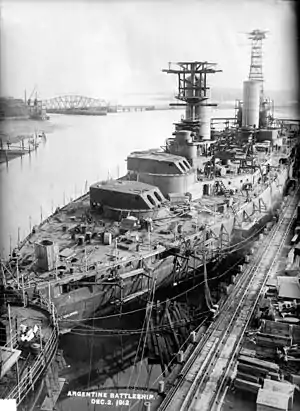
Selected article 17
Portal:Argentina/Selected article/17
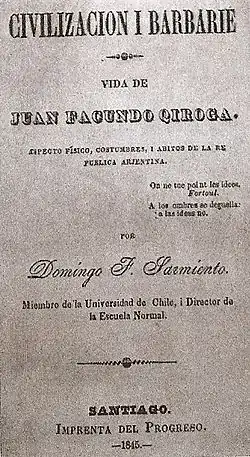
Facundo describes the life of Juan Facundo Quiroga, a gaucho who had terrorized provincial Argentina in the 1820s and 1830s. Kathleen Ross, one of Facundos English translators, points out that the author also published Facundo to "denounce the tyranny of the Argentine dictator Juan Manuel de Rosas". Sarmiento sees Rosas as heir to Facundo: both are caudillos and representatives of a barbarism that derives from the nature of the Argentine countryside. ('Full article...)
Selected article 18
Portal:Argentina/Selected article/18
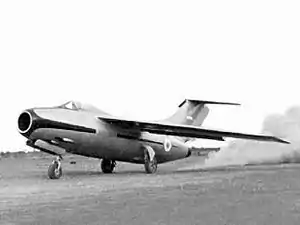
Selected article 19
Portal:Argentina/Selected article/19
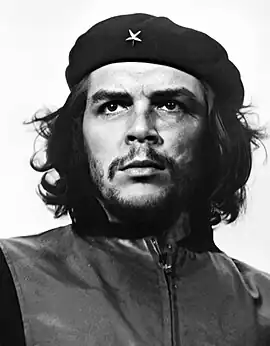
As a young medical student, Guevara traveled throughout Latin America and was radically transformed by the endemic poverty and alienation he witnessed. His experiences and observations during these trips led him to conclude that the region's ingrained economic inequalities were an intrinsic result of capitalism, monopolism, neocolonialism, and imperialism, with the only remedy being world revolution. (Full article...)
Selected article 20
Portal:Argentina/Selected article/20

The May Revolution was a direct reaction to Spain's Peninsular War of the previous two years. In 1808 King Ferdinand VII of Spain, abdicated in favor of Napoleon, who granted the throne to his brother, Joseph Bonaparte. A Supreme Central Junta led resistance to Joseph's government and the French occupation of Spain, but eventually suffered a series of reversals that resulted in the loss of the northern half of the country. On February 1, 1810, French troops took Seville and gained control of most of Andalusia. The Supreme Junta retreated to Cadiz and dissolved itself, being replaced by the Council of Regency of Spain and the Indies. News of these events arrived in Buenos Aires on May 18, when British ships brought newspapers from Spain and the rest of Europe. (Full article...)
Selected article 21
Portal:Argentina/Selected article/21
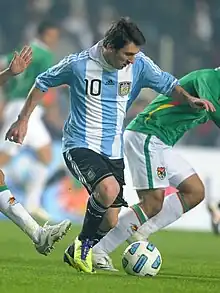
Messi was the top scorer of the 2005 FIFA World Youth Championship with six goals, including two in the final game. Shortly thereafter, he became an established member of Argentina's senior international team. In 2006, he became the youngest Argentine to play in the FIFA World Cup and he won a runners-up medal at the Copa América tournament the following year. In 2008, in Beijing, he won his first international honour, an Olympic gold medal, with the Argentina Olympic football team. At international level Messi has scored 17 goals in 61 games. (Full article...)
Selected article 22
Portal:Argentina/Selected article/22

Although he was not prominently involved in the May Revolution that deposed Cisneros, he was appointed as secretary of war of the new government, the Primera Junta. Along with Juan José Castelli, he promoted harsh policies against the supporters of the former government and the strengthening of the new one. These policies were detailed at a secret document, the Operations plan; some historians dispute its authorship. Moreno organized military campaigns to Paraguay and Upper Peru, and ensured the execution of Santiago de Liniers after the defeat of his counter-revolution. He established the first Argentine newspaper, La Gazeta de Buenos Ayres, and translated Jean-Jacques Rousseau's The Social Contract into Spanish. (Full article...)
Selected article 23
Portal:Argentina/Selected article/23 María Eva Duarte de Perón (Spanish: [maˈɾi.a ˈeβa ˈðwarte ðe peˈɾon]; 1919–1952) was the second wife of President Juan Perón (1895–1974) and served as the First Lady of Argentina from 1946 until her death in 1952. She is often referred to as simply Eva Perón, or by the affectionate Spanish language diminutive Evita.
In 1951, Eva Perón renounced the Peronist nomination for the office of Vice President of Argentina. In this bid, she received great support from the Peronist political base, low-income and working class Argentines who were referred to as descamisados or "shirtless ones". However, opposition from the nation's military and bourgeoisie, coupled with her declining health, ultimately forced her to withdraw her candidacy. In 1952 shortly before her death from cancer at the age of 33, Eva Perón was given the official title of "Spiritual Leader of the Nation" by the Argentine Congress. Eva Perón was given an official state funeral despite the fact that she was not an elected head of state. (Full article...)
Selected article 24
Portal:Argentina/Selected article/24

He completed the second longest winning streak in 2008, and the second longest by a teenager in the Open Era, behind Rafael Nadal—with his winning sequence spanning 23 matches over five tournaments. Del Potro captured his first Grand Slam title at the 2009 US Open defeating Nadal in the semifinal, and Roger Federer in the final, becoming the first to beat both Federer and Nadal in the same Grand Slam tournament (later achieved by Novak Djokovic at the 2011 US Open). He became the second Argentine and the fifth youngest man to win the US Open title in the Open Era. (Full article...)
Selected article 25
Portal:Argentina/Selected article/25
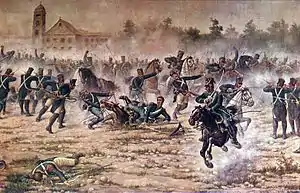
Montevideo, a royalist stronghold during the Argentine War of Independence, was under siege by José Gervasio Artigas. The city raided population centres along the nearby rivers for supplies. José de San Martín, who shortly before had arrived in Buenos Aires and formed the regiment, followed the royalist ships to San Lorenzo. The area around San Lorenzo formed a large empty plain, the regiment hid inside the San Carlos convent during the night and San Martín studied the battlefield and the enemy ships from the tower. The battle started at the dawn whereupon the grenadiers made a surprise pincer movement to trap the enemy forces. One column was led by San Martín, and the other by Justo Germán Bermúdez. The Royalists were led by Antonio Zabala. San Martín fell from his horse, and was nearly killed, but Juan Bautista Cabral and Juan Bautista Baigorria intervened and saved him. The royalists were defeated, but kept raiding villages for some more time afterwards. (Full article...)
Selected article 26
Portal:Argentina/Selected article/26
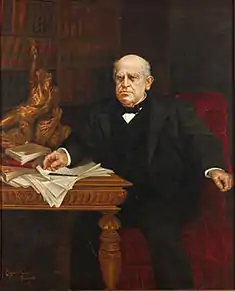
Sarmiento grew up in a poor but politically active family that paved the way for much of his future accomplishments. Between 1843 and 1850 he was frequently in exile, and wrote in both Chile and in Argentina. His greatest literary achievement was Facundo, a critique of Juan Manuel de Rosas, that Sarmiento wrote while working for the newspaper El Progreso during his exile in Chile. The book brought him far more than just literary recognition; he expended his efforts and energy on the war against dictatorships, specifically that of Rosas, and contrasted enlightened Europe—a world where, in his eyes, democracy, social services, and intelligent thought were valued—with the barbarism of the gaucho and especially the caudillo, the ruthless strongmen of nineteenth-century Argentina. (Full article...)
Selected article 27
Portal:Argentina/Selected article/27

Selected article 28
Portal:Argentina/Selected article/28

His first release with the label, Lo Mejor del Amor, became an instant radio hit, earning him national fame and an ACE Award for Best Musical Act. The success was followed by La Leyenda Continúa (certified gold by CAPIF) and Cuarteteando. His 1999 release A 2000 became the theme of a series of concerts begun in the Astral Theater and held the following year in the Luna Park Arena under the name of Cuarteto Característico Rodrigo A 2000 ("Characteristic Cuarteto, Rodrigo to 2000"). His death caused an immediate sensation in the Argentine media. (Full article...)
Selected article 29
Portal:Argentina/Selected article/29
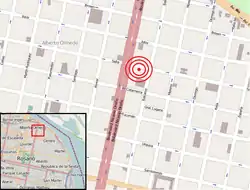
The provincial judiciary, headed by judges Juan Carlos Curto, Javier Beltramone and Patricia Bilotta, launched an investigation of the cause of the explosion. Primary suspects were Litoral Gas (the natural-gas provider) and an employee who did maintenance work at the building that day. Several public figures sent condolences, and most candidates for the 2013 primary elections suspended their political campaigns. (Full article...)
Selected article 30
Portal:Argentina/Selected article/30

The series was written by Sebastián Ortega, and produced by Endemol and Underground producciones. It included several cameos and guest appearances of Argentine Rock artists. Graduados was very successful, winning in the ratings race over the blockbuster Showmatch. It received the 2012 Golden Martín Fierro award, seven Martín Fierro awards and ten Tato Awards, including the Tato Award for the 2012 program of the year. (Full article...)
Selected article 31
Portal:Argentina/Selected article/31
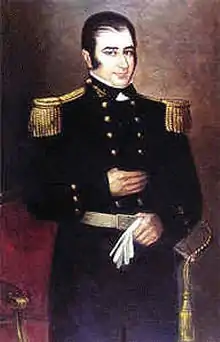
Hippolyte de Bouchard, or Hipólito de Bouchard (1780 - 1837), was a French and Argentine sailor and corsair who fought for Argentina, Chile, and Peru. During his first campaign as an Argentine corsair he attacked the Spanish colonies of Chile and Peru, under the command of the Argentine-Irish Admiral William Brown. He was the first Argentine to circumnavigate the world. During his voyage around the world he blockaded the port of Manila and recovered, in Hawaii, an Argentine privateer which had been seized by mutineers, where he also met the local ruler, King Kamehameha I. His forces occupied Monterey, California, then a Spanish colony, raising the Argentine flag there and claiming for his country, for a short time, a small portion of the future State of California. After raiding Monterey, he plundered Mission San Juan Capistrano in Southern California. Toward the end of the voyage Bouchard raided the Spanish ports in Central America. Therefore, in his second homeland he is remembered as a hero and patriot; several places are named in his honour...
Selected article 32
Portal:Argentina/Selected article/32

The Battle of Tacuarí (9 March 1811) was a battle in Southern Paraguay between revolutionary forces under the command of General Manuel Belgrano, member of the Primera Junta government of Argentina, and Paraguayan troops under colonel Manuel Atanasio Cabañas, at the time at the service of the royalists.
After the May Revolution in Buenos Aires, capital of the Viceroyalty of the Río de la Plata, the Primera Junta government invited the other cities and provinces to join the revolution. Any intent of preserving the local governments previous to the revolution were considered hostile; and as a consequence two military campaigns were launched to suppress the resistance, one to Upper Peru and another to Paraguay, whose Spanish governor, Bernardo de Velasco, had refused to recognize the Junta and had received political support from the Cabildo of Asunción...
Selected article 33
Portal:Argentina/Selected article/33
.png.webp)
The Army of the North (Spanish: Ejército del Norte), contemporaneously called Army of Peru, was one of the armies deployed by the United Provinces of the Río de la Plata in the Spanish American wars of independence. Its objective was freeing the Argentine Northwest and the Upper Peru (present-day Bolivia) from the royalist troops of the Spanish Empire
The offensive operations started in 1810 and ended in 1817, with the defeat of the forces commanded by Gregorio Aráoz de La Madrid at the battle of Sopuchay, the last attempt to advance into Upper Peru. Since then, only defensive operations on the Northern frontier were carried on, as the offensive had been transferred to the Army of the Andes, commanded by José de San Martín, who devised the strategy of reaching the main royalist stronghold, Lima, through Chile. In 1820 the Army of the North was summoned to intervene in the internal strife between the central government in Buenos Aires and the Federal League provincial caudillo leaders. Shortly after, the Arequito Revolt led by the independentist veterans who refused to fight a civil war instead of an independence war, effectively ended the existence of the Army of the North...
Selected article 34
Portal:Argentina/Selected article/34
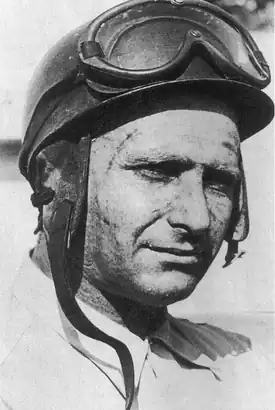
Juan Manuel Fangio (Balcarce, June 24, 1911 - Buenos Aires, July 17, 1995), nicknamed "El Chueco" ("knock-kneed") or "El Maestro" ("The Master"), was a race car driver from Argentina, who dominated the first decade of Formula One racing. He won five Formula One World Driver's Championships — a record which stood for 46 years eventually beaten by Michael Schumacher — with four different teams (Alfa Romeo, Ferrari, Mercedes-Benz and Maserati), a feat that has not been repeated since. He is the only Argentine driver to have won the Argentine Grand Prix, having won it four times in his career...
Selected article 35
Portal:Argentina/Selected article/35
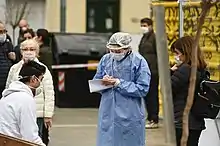
The COVID-19 pandemic in Argentina was a part of the worldwide pandemic of coronavirus disease 2019 (COVID-19) caused by severe acute respiratory syndrome coronavirus 2 (SARS-CoV-2). As of 25 October 2023, a total of 10,054,576 people were confirmed to have been infected, and 130,472 people were known to have died because of the virus.
On 3 March 2020, the virus was confirmed to have spread to Argentina. On 7 March 2020, the Ministry of Health confirmed the country's first documented death, a 64-year-old man who had travelled to Paris, France, who also had other health conditions; the case was only confirmed as positive after the patient's demise. (Full article...)
Selected article 36
Portal:Argentina/Selected article/36
Lesbian, gay, bisexual, and transgender (LGBT) rights in Argentina rank among the highest in the world. Upon legalising same-sex marriage on 15 July 2010, Argentina became the first country in Latin America, the second in the Americas, and the tenth in the world to do so. Following Argentina's transition to a democracy in 1983, its laws have become more inclusive and accepting of LGBT people, as has public opinion.
Argentina also "has one of the world's most comprehensive transgender rights laws": its Gender Identity Law, passed in 2012, allows people to change their legal gender without facing barriers such as hormone therapy, surgery or psychiatric diagnosis that labels them as having an abnormality. Because of the law, as well as the creation of alternative schools and the first transgender community centre, BBC Mundo reported in 2014 that "Argentina leads the trans revolution in the world." In 2015, the World Health Organization cited Argentina as an exemplary country for providing transgender rights. (Full article...)
Selected article 37
Portal:Argentina/Selected article/37 Portal:Argentina/Selected article/37
Selected article 38
Portal:Argentina/Selected article/38 Portal:Argentina/Selected article/38
Selected article 39
Portal:Argentina/Selected article/39 Portal:Argentina/Selected article/39
Selected article 40
Portal:Argentina/Selected article/40 Portal:Argentina/Selected article/40
Archive
For the old, now disused, selected article page see: Portal:Argentina/Selected article (old)
.svg.png.webp)